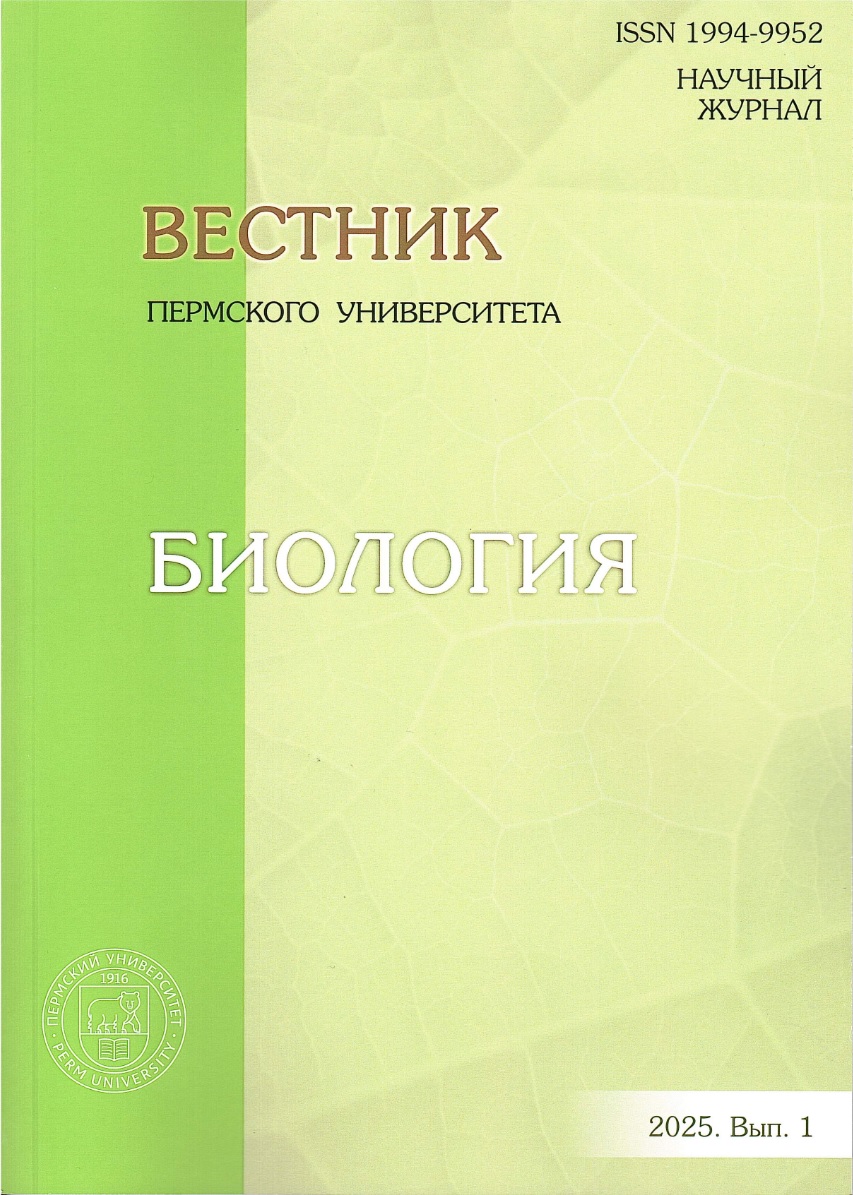Microbiological analysis of peat therapeutic mud from the Taborli-3 deposit
Main Article Content
Abstract
Article Details
References
Вавилин В.А. Время оборота биомассы и деструкция органического вещества в системах биологи-ческой очистки. М.: Наука, 1986. 144 с.
Гайдукова Т.Ю. и др. Торфяные лечебные грязи: новые подходы к реабилитации пациентов после операций на позвоночнике // Вопросы курортологии, физиотерапии и лечебной физической культуры. 2023. Т. 100, № 3-2. С. 58–59. EDN: ZQECTW
Злотников А.К. и др. Физиологические и биохимические свойства бактериальной ассоциации Klebsiella terrigena E6 и Bacillus firmus E3 // Прикладная биохимия и микробиология. 2007. Т. 43, № 3. С. 338–346. EDN: IAGBQD
Максимов Г.С. и др. Минеральный состав грязи Сакского месторождения // Минералы: строение, свойства, методы исследования. 2021. № 12. С. 91–92. EDN: ALIZSF
Марданова А.М. и др. Поиск и выделение новых штаммов бактерий-антагонистов фитопатогенных микромицетов рода Fusarium // Биоразнообразие и экология грибов и грибоподобных организмов Север-ной Евразии: материалы Всерос. конф. Екатеринбург, 2015. С. 149–151.
Нагызбеккызы Э. и др. Выделение и скрининг микроорганизмов, перспективных при создании на их основе заквасок для получения биогаза из сточной воды // Научное обозрение. Биологические науки. 2022. Т. 3. С. 27–33. doi: 10.17513/srbs.1280. EDN: TGXJXR
Паспорт месторождения Таборли-3 [Электронный ресурс]. URL: http://reports.geologyscience.ru/kadastr_view_one.php?id=43154 (дата обращения: 04.12.2023).
Пелоидотерапия больных бронхиальной астмой с сопутствующей патологией / И.И. Антипова, Т.Н. Зарипова, Н.Н. Симагаева и др. Томск: STT, 2012. 244 с.
Перспективы развития санаторно-курортного туризма в регионе (на материалах Республики Та-тарстан) / Г.Н. Булатова, Э.И. Байбаков, В.А. Рубцов и др. // Приоритетные направления и проблемы развития внутреннего и международного туризма в России: материалы IV Всерос. с междунар. участием науч.-практ. конф, Симферополь, 2020. С. 204–208.
Санаторий Шифалы Су Ижминводы [Электронный ресурс] // Санаторий Шифалы Су Ижминво-ды: официальный сайт. URL: https://xn--f1adbpg.xn--p1ai/%D0%BB%D0%B5%D1%87%D0% B5%D0%BD%D0%B8%D0%B5/%D0%BF%D1%80%D0%B8%D1%80%D0%BE%D0%B4%D0%BD%D1%8B%D0%B5-%D0%BB%D0%B5%D1%87%D0%B5%D0%B1%D0%BD%D1%8B%D0%B5-%D1%84%D0% B0%D0%BA%D1%82%D0%BE%D1%80%D1%8B/#torf (дата обращения: 04.12.2023).
Таборли-3 [Электронный ресурс]: Российский федеральный геологический фонд: официальный сайт. URL: https://www.rfgf.ru/gkm/itemview.php?id=43154 (дата обращения: 04.12.2023).
Tatarica: Татарская энциклопедия. [Электронный ресурс]. Казань, 2018. URL: https://tatarica.org/ru (дата обращения: 04.12.2023).
Ялтанец И.М. и др. Научно-практическое использование сапропелевых илов и торфяных грязей в комплексном санаторно-курортном лечении // Горный информационно-аналитический бюллетень. 2004. № 12. С. 28–39. EDN: MUMDST
Adefiranye O.O. et al. Draft genome of Lysinibacillus fusiformis PwPw_T2 isolated from Ananas como-sus revealing acetic acid producing and xenobiotic degrading enzymes // Microbiol. Resour. Announc. 2023. Vol. 12, № 12. Art. 0075323. doi: 10.1128/MRA.00753-23.
Bagade A. et al. Characterisation of hyper tolerant Bacillus firmus L-148 for arsenic oxidation // Environ Pollut. 2020. Vol. 261. Art. 114124. doi: 10.1016/j.envpol.2020.114124.
Barathi S. et al. Biodegradation of textile dye Reactive Blue 160 by Bacillus firmus (Bacillaceae: Bacil-lales) and non-target toxicity screening of their degraded products // Toxicol. Rep. 2019. Vol. № 7. Р. 16–22. doi: 10.1016/j.toxrep.2019.11.017.
DeSantis T.Z. et al. Greengenes, a chimera-checked 16S rRNA gene database and workbench compatible with ARB // Appl. Environ. Microbiol. 2006. Vol. 72, №7. Р. 5069–5072. doi: 10.1128/aem.03006-05.
Guffanti A.A. et al. Bioenergetic Properties of Alkaline-tolerant and Alkalophilic Strains of Bacillus // Journal of General MicrobioIogy. 1980. Vol. 119, № 1. Р. 79–86. doi: 10.1099/00221287-119-1-79.
John W.C. et al. Evaluation of biosurfactant production potential of Lysinibacillus fusiformis MK559526 isolated from automobile-mechanic-workshop soil // Braz. J. Microbiol. 2021. Vol. 52, № 2. Р. 663–674. doi: 10.1007/s42770-021-00432-3.
Kawahara K. et al. Occurrence of an alpha-galacturonosyl-ceramide in the dioxin-degrading bacterium Sphingomonas wittichii // FEMS Microbiol. Lett. 2002. Vol. 214, № 2. Р. 289–294. doi: 10.1111/j.1574-6968.2002.tb11361.x.
Mandal K. et al. Bioremediation of fipronil by a Bacillus firmus isolate from soil // Chemosphere. 2014. Vol. 101. Р. 55–60. doi: 10.1016/j.chemosphere.2013.11.043.
Mehta J. et al. Decolourization of simulated dye in aqueous medium using bacterial strains // European Journal of Advances in Engineering and Technology. 2015. Vol. 2, № 3. Р. 9–18.
Nagpal S. et al. iVikodak-A platform and standard workflow for inferring, analyzing, comparing, and visualizing the functional potential of microbial communities // Front Microbiol. 2019. Vol. 9. Art. 3336. doi: 10.3389/fmicb.2018.03336.
Nandy S. et al. Community Acquired Bacteremia by Sphingomonas paucimobilis: Two Rare Case Re-ports // J. Clin. Diagn. Res. 2013. Vol. 7, № 12. Р. 2947–2949. doi: 10.7860/JCDR/2013/6459.3802.
Oren A., Göker M., Sutcliffe I.C. Executive Board of the International Committee on Systematics of Prokaryotes. New Phylum Names Harmonize Prokaryotic Nomenclature // mBio. 2022. Vol. 13, № 5. Art. 0147922. doi: 10.1128/mbio.01479-22.
Passera A. et al. Characterization of Lysinibacillus fusiformis strain S4C11: In vitro, in planta, and in sili-co analyses reveal a plant-beneficial microbe // Microbiol Res. 2021. Vol. 244. Art. 126665. doi: 10.1016/j.micres.2020.126665.
Prihanto A.A. et al. Optimization of glutaminase-free L-asparaginase production using mangrove endo-phytic Lysinibacillus fusiformis B27 // F1000 Res. 2019. Vol. 8. Art. 1938. doi: 10.12688/f1000research.21178.2.
Prokesová L. et al. Immunostimulatory effect of Bacillus firmus on mouse lymphocytes // Folia Micro-biol. (Praha). 2002. Vol. 47, № 2. Р.193–197. doi: 10.1007/BF02817682.
Rashmi M. et al. Biodegradation of di-2-ethylhexyl phthalate by Bacillus firmus MP04 strain: paramet-ric optimization using full factorial design // Biodegradation. 2023. Vol. 34, № 6. Р. 567–579. doi: 10.1007/s10532-023-10043-4.
Reyes-Cervantes A. et al. Evaluation in the performance of the biodegradation of herbicide diuron to high concentrations by Lysinibacillus fusiformis acclimatized by sequential batch culture // J. Environ. Manage. 2021. Vol. 291. Art. 112688. doi: 10.1016/j.jenvman.2021.112688.
Teeravivattanakit T. et al. Digestibility of Bacillus firmus K-1 pretreated rice straw by different commer-cial cellulase cocktails // Prep. Biochem. Biotechnol. 2022. Vol. 52, № 5. Р. 508–513. doi: 10.1080/10826068.2021.1969575.
Wu S. et al. Simultaneous nitrogen removal via heterotrophic nitrification and aerobic denitrification by a novel Lysinibacillus fusiformis B301 // Water Environ. Res. 2023. Vol. 95, № 3. Art. e10850. doi: 10.1002/wer.10850.




